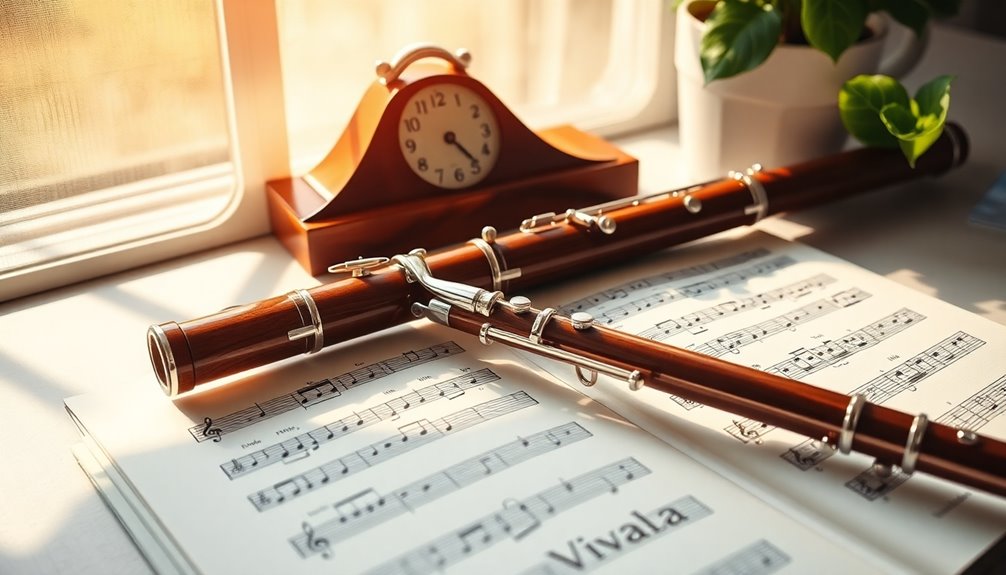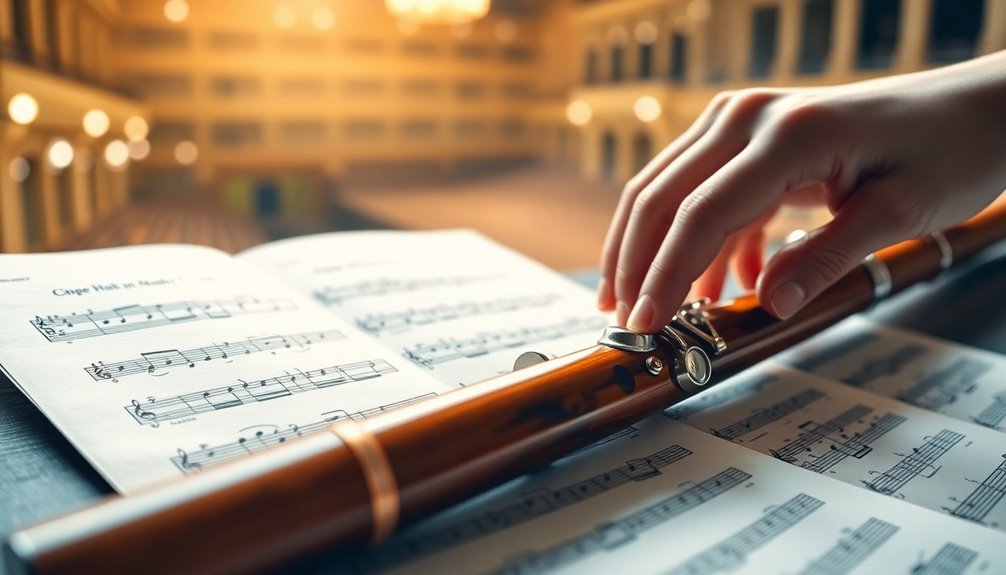As a flutist, you should definitely know these ten famous pieces that showcase the flute's beauty and versatility. Start with Mozart's Flute Concerto No. 1, then explore Bach's Partita in A Minor for its deep emotional resonance. Don't miss Debussy's Syrinx, a true masterpiece of impressionism. Vivaldi's Flute Concerto in D Major and Doppler's Fantaisie Pastorale Hongroise will challenge your technical skills. Ibert's Concerto offers a blend of lyrical and spirited sections. C.P.E. Bach's Sonata and Takemitsu's Voice push boundaries, while Nielsen's concerto rounds out the list. Each piece opens the door to unique expressions and techniques that you can master. Keep going to discover even more insights!
Key Takeaways
- Mozart's Flute Concerto No. 1 is essential for its lyrical beauty and technical brilliance, representing the Classical era's style.
- Vivaldi's Flute Concerto in D Major showcases vibrant melodies and unique challenges, making it a staple in the flute repertoire.
- Bach's Partita in A Minor combines technical mastery with emotional depth, reflecting dance forms of its time.
- Debussy's Syrinx embodies impressionism, offering evocative melodies and opportunities for personal interpretation and storytelling.
- Doppler's Fantaisie Pastorale Hongroise blends virtuosity with lyricism, challenging flutists to master various techniques and styles.
Mozart: Flute Concerto No. 1

When you immerse yourself in Mozart's Flute Concerto No. 1, you'll discover a masterpiece that showcases the instrument's lyrical beauty and technical brilliance. Composed in 1778, this concerto reflects Mozart's influences, particularly the Classical era's emphasis on clarity and balance. You'll notice how he masterfully blends the flute's expressive qualities with a rich orchestral backdrop, inviting you to explore the intricate dialogue between the soloist and the ensemble.
As you investigate the piece, pay attention to the various flute techniques Mozart employs. From rapid passages that challenge your dexterity to soaring melodies that require breath control and phrasing, this concerto offers a thorough study in flute performance. Each movement presents unique opportunities for you to express emotion and showcase your technical skills.
Moreover, performing this work can foster a sense of belonging within the broader music community. Whether you're playing in a solo setting or collaborating with an orchestra, you'll connect with fellow musicians who share your passion for this timeless piece. Embrace the chance to engage with Mozart's genius and interpret his music in your unique way.
Ultimately, studying and performing Mozart's Flute Concerto No. 1 not only enhances your flute techniques but also enriches your musical journey, creating lasting bonds with others who appreciate this extraordinary work. Additionally, incorporating advanced flute techniques into your practice will further elevate your performance and deepen your understanding of this iconic concerto.
Bach: Partita in A Minor

Delving into Bach's Partita in A Minor for solo flute reveals a work that's both challenging and rewarding. This piece showcases Bach's unparalleled ability to blend technical mastery with deep emotional expression. As you approach this partita, understanding Bach's influences—particularly from the dance forms of his time—can enrich your interpretation and performance.
The Partita is structured in a series of movements, each rich with complexity and character. In your Partita analysis, pay attention to the contrasting styles, from the lively Allemande to the delicate Sarabande. Each movement invites you to explore different aspects of your playing, pushing you to refine your technique while allowing your personal expression to shine through.
While the technical demands may seem intimidating at first, don't let that discourage you. Embrace the challenge! Every practice session is an opportunity to grow as a musician and connect with the music on a deeper level. Understanding the historical context of the piece can further enhance your rendition.
Break down the movements, focusing on challenging passages, and soon you'll find that what once felt overwhelming becomes manageable and even enjoyable.
Debussy: Syrinx

Exploring Debussy's "Syrinx" reveals a masterpiece that captures the essence of impressionism through its evocative melodies and fluid structure. Written in 1913 for a theatrical performance, this solo flute piece showcases Debussy's influence on modern music and the way he redefined the capabilities of the instrument.
As you immerse yourself in "Syrinx," you'll find that its hauntingly beautiful lines invite personal interpretation, allowing each musician to convey their unique emotional response.
When approaching your own Syrinx interpretation, consider the subtleties in dynamics and phrasing. The piece is rich with contrasts, from soft, delicate whispers to bold, expressive flourishes. This duality not only highlights your technical skills but also your ability to tell a story through music. Additionally, the ease of play noted by many using flutes like the Rhythm C Flutes can enhance your confidence while interpreting this complex work.
Take your time to explore the nuances; after all, each note can evoke a different feeling.
"Syrinx" serves as a bridge between tradition and innovation, inviting flutists to connect with their listeners on a deeper level. As you practice, think about how you can embody the spirit of the piece, making it your own while honoring Debussy's vision.
Vivaldi: Flute Concerto in D Major

In the vibrant world of Baroque music, Vivaldi's "Flute Concerto in D Major" stands out as a lively and engaging piece that showcases the flute's brilliance. This concerto is a perfect example of Vivaldi's style, characterized by rich melodies and intricate ornamentation.
As you investigate this work, you'll notice how it captures the joyous spirit typical of the Baroque era, inviting you to play expressively and with enthusiasm.
The concerto structure of this piece typically features three movements: fast-slow-fast. Each section offers unique challenges and opportunities for expression. The first movement bursts with energy, with rapid passages that require precision and agility. It's a chance for you to demonstrate your technical skills while immersing yourself in the music's vibrant rhythms.
The second movement provides a contrasting lyrical section, allowing you to showcase your ability to convey emotion through phrasing and dynamics. Finally, the concluding movement returns to the lively tempo, encouraging you to bring everything together in a jubilant finale.
As you explore Vivaldi's "Flute Concerto in D Major," remember that it's not just about the notes; it's about connecting with the music and sharing that experience with your audience. Additionally, practicing regularly using resources like the Rubank Elementary Method can significantly enhance your flute skills.
Embrace the joy of playing this piece, and you'll find a sense of belonging within the rich tapestry of Baroque music. So grab your flute, plunge into this masterpiece, and let your passion shine through!
Doppler: Fantaisie Pastorale Hongroise

After experiencing the lively energy of Vivaldi's "Flute Concerto in D Major," you'll find Doppler's "Fantaisie Pastorale Hongroise" offers a beautifully contrasting soundscape. This piece showcases the intricacies of the flute while drawing inspiration from Hungarian themes, making it a staple for flutists seeking to explore diverse cultural expressions through music.
Doppler, a 19th-century composer and flutist, is well-known for his ability to blend technical brilliance with lyrical beauty. His influence can be felt in "Fantaisie Pastorale Hongroise," where you'll navigate through sweeping melodies and lively rhythms that evoke the spirit of Hungary.
As you play, you'll notice how the piece allows for expressive phrasing and dynamic contrasts, inviting you to infuse your interpretation with personal flair. One of the joys of mastering this piece is the way it connects you to the broader flute community, reflecting the emotional resonance of traditional melodies that weave storytelling elements into each note.
When you share your performance, you're not just showcasing your skill; you're also celebrating the rich heritage of flute music influenced by various cultures, including Doppler's Hungarian roots. You'll find that this work resonates with both audiences and fellow musicians, fostering a sense of belonging and camaraderie.
As you explore deeper into "Fantaisie Pastorale Hongroise," embrace the challenge it presents. With dedication and practice, you can capture the essence of Doppler's unique style and contribute to the ongoing legacy of this enthralling music.
Poulenc: Sonata for Flute and Piano

One of the most celebrated works in the flute repertoire, Poulenc's "Sonata for Flute and Piano" captivates with its vibrant melodies and rich harmonies. Written in 1957, this piece showcases Poulenc's influences from both French impressionism and neoclassicism, blending lyrical expressiveness with a playful spirit.
As you immerse yourself in the Sonata, you'll discover the intricate interplay between the flute and piano, each voice complementing the other beautifully.
The Sonata structure consists of three movements: Allegretto, Andante, and Allegro. This arrangement not only highlights the unique character of each movement but also allows you to explore a range of emotions, from the introspective to the exuberant.
The first movement features a lighthearted theme that's both catchy and inviting, while the Andante offers a moment of reflection, drawing you into its poignant melodies. Finally, the spirited Allegro propels you forward, urging you to embrace the joyous energy that Poulenc masterfully crafts.
As you work on this piece, you'll find that it challenges your technical skills and artistic expression simultaneously. Don't be discouraged if it takes time to master—each practice session brings you closer to capturing Poulenc's essence. Additionally, consider incorporating extended techniques that can further enhance your interpretation and performance.
Join a community of flutists who appreciate this work, and share your interpretations. By embracing Poulenc's "Sonata for Flute and Piano," you're not just connecting with a piece of music; you're joining a rich tradition that celebrates creativity and collaboration in the world of flute playing.
Ibert: Concerto for Flute and Orchestra

Exploring the rich landscape of flute concertos, Ibert's "Concerto for Flute and Orchestra" stands out as a vibrant showcase of the instrument's capabilities. Composed in 1934, this piece reflects Ibert's influences, particularly the French impressionists and the lively rhythms of jazz. You'll find that its energetic themes and intricate passages invite both performers and listeners into a world of color and emotion.
The concerto structure is thoughtfully crafted, divided into three movements that offer a delightful contrast between lyrical melodies and spirited sections. From the very first notes, you're met with a playful dialogue between the flute and the orchestra.
As a flutist, you'll appreciate how Ibert allows the flute to shine, demanding technical prowess while also expressing profound musicality. In the second movement, a more introspective and lyrical quality emerges, showcasing the flute's ability to convey deep emotion. It's a moment where you can truly connect with the music, allowing your personal interpretation to flourish.
Finally, the exhilarating third movement brings back the lively energy, making it an exhilarating finish that leaves both you and your audience breathless.
As you explore Ibert's "Concerto for Flute and Orchestra," remember that this piece not only challenges you as a player but also celebrates the unique voice of the flute. Embrace the journey, and let Ibert's work inspire you to reach new heights in your flute playing! Additionally, mastering articulation techniques will enhance the expressiveness of your performance in this intricate concerto.
C.P.E. Bach: Sonata in A Minor

Composed in the mid-18th century, C.P.E. Bach's Sonata in A Minor stands as a significant piece in the flute repertoire. This sonata, a remarkable example of the empfindsamer Stil, or "sensitive style," captures the essence of emotional expression that C.P.E. Bach was known for.
As you explore the sonata analysis, you'll notice how the intertwining melodies and dynamic contrasts create a dialogue that resonates deeply with both the performer and the listener.
The sonata consists of three movements: the lively Allegro, the expressive Andante, and the spirited Allegro. Each movement presents unique challenges and opportunities for you to showcase your technical skills while conveying emotion.
The interplay between the flute and the keyboard part encourages a collaborative spirit, making it an excellent choice for chamber music.
As you practice this sonata, focus on the nuances and phrasing that bring out the dramatic contrasts inherent in C.P.E. Bach's writing. Pay attention to the articulation and dynamics; they play an essential role in delivering the emotional depth of the piece. Additionally, this sonata serves as a valuable tool for refining your technical skills and meeting instructor standards.
Takemitsu: Voice

While delving into Takemitsu's "Voice," you'll discover a mesmerizing piece that pushes the boundaries of traditional flute music. This composition invites you to explore the intricate relationship between sound and silence, encouraging a deep emotional connection with your audience.
Takemitsu's innovative techniques challenge you to transcend conventional flute interpretations, allowing your creativity to flourish. As you approach "Voice," pay close attention to the various Takemitsu techniques woven throughout the piece. He employs multiphonics, flutter-tonguing, and whispering tones to create a rich tapestry of sound.
These elements not only enhance the music but also require you to engage fully with your instrument. Embracing these techniques will expand your skill set and deepen your understanding of contemporary flute repertoire. Additionally, developing a strong embouchure control is essential for executing these advanced techniques effectively.
When performing "Voice," it's crucial to focus on the nuances of expression. Each note carries emotional weight, and your interpretation can shift the atmosphere of the piece dramatically.
Take time to experiment with dynamics, phrasing, and timing, allowing each performance to reflect your unique voice as a flutist. Remember, this isn't just about technical proficiency; it's about telling a story.
Nielsen: Concerto for Flute and Orchestra

Exploring Nielsen's "Concerto for Flute and Orchestra," you'll encounter a vibrant and dynamic work that showcases the flute's versatility within an orchestral setting. Composed in 1926, this concerto reflects Nielsen's influences, particularly from the natural world and Danish folk music. You'll notice how he masterfully intertwines these elements, creating a rich tapestry of sound that invites you to examine the depths of your instrument.
The concerto structure is distinctive, consisting of three movements that shift in mood and tempo. Each movement presents unique challenges and opportunities for expression, urging you to push your technical and emotional boundaries.
The first movement opens with an energetic flourish, demanding agility and a keen sense of rhythm. You'll feel invigorated as you navigate through the intricate passages.
As you explore the lyrical second movement, you can truly express yourself. The hauntingly beautiful melodies allow you to connect with the audience on a profound level, showcasing not just your technical skill but your musicality as well.
Finally, the exuberant third movement brings everything full circle, culminating in a celebration of sound and spirit.
Playing Nielsen's concerto can feel like a rite of passage for flutists. It invites you to embrace both the challenges and joys of performance while feeling connected to a larger musical tradition. Additionally, this piece emphasizes the importance of collaboration between flute and orchestra, enhancing the overall performance experience.
Frequently Asked Questions
What Are the Best Practice Techniques for These Flute Pieces?
To master any flute piece, you'll want to develop effective practice routines. Start with warm-up exercises to improve your tone and technique. Focus on scales and arpeggios, gradually increasing speed.
Break the pieces into manageable sections and practice them slowly before speeding up. Don't forget to listen to recordings for inspiration!
Consistency is key, so set aside regular time for practice. You'll feel a sense of belonging as you progress and connect with others.
How Can I Improve My Flute Tone for These Compositions?
Think of your flute tone as a beautiful garden, requiring care and attention to flourish.
To improve your tone production, focus on breath control; take deep, relaxed breaths, letting your diaphragm do the work. Experiment with different embouchures and practice long tones daily to build consistency.
What Age Is Appropriate to Start Learning These Pieces?
The appropriate age to start learning these pieces can vary, but most flutists begin around age 8 or 9.
At this age, you can grasp basic techniques and develop your skills. As you progress, you'll find that tackling more challenging compositions becomes enjoyable and fulfilling.
Are There Any Specific Editions of These Scores Recommended?
When it comes to recommended editions of flute scores, you'll find several options that cater to different skill levels.
Look for editions published by reputable companies like Peters or Schirmer, as they offer reliable notation and clear fingerings.
You can often find score availability online, making it easy to access the pieces you want to learn.
Don't hesitate to explore various editions—each one can enhance your understanding and enjoyment of the music.
How Long Does It Typically Take to Master These Pieces?
Mastering a piece can feel like climbing a mountain; each step builds your skill progression.
Typically, the mastery timeline varies based on your experience and practice habits. For beginners, it might take months, while advanced players could refine their skills in weeks.
Conclusion
As you explore these ten iconic flute pieces, think of each note as a stepping stone on your musical journey. Each composition offers a unique voice, inviting you to express your emotions through the delicate whispers and soaring melodies of the flute. Embrace the challenge, and let these masterpieces inspire you to grow as a musician. Remember, every great flutist started just where you are—so pick up your flute and let the music carry you away!





